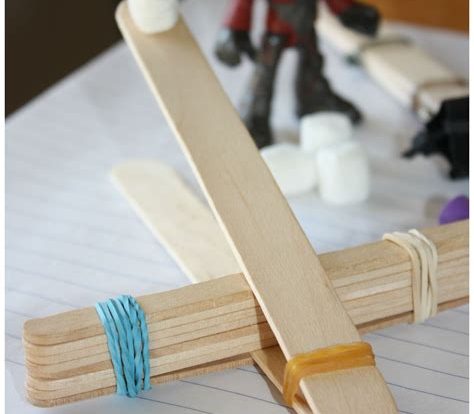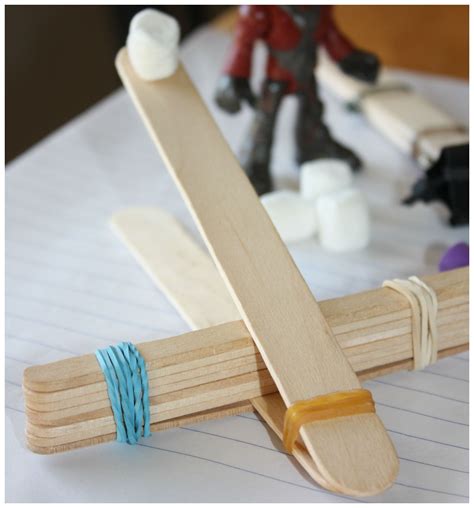

Learn how to build a catapult in just a few easy steps. Create your own DIY catapult with everyday materials and start launching objects today!
Building a catapult may seem like a daunting task, but with the right materials and a little bit of know-how, anyone can create their very own medieval siege weapon. Whether you’re looking to impress your friends or dominate your next office warfare battle, a catapult is sure to do the trick. However, before you start gathering supplies, it’s important to consider what type of catapult you want to build. From the classic trebuchet to the more modern ballista, each design offers its own unique strengths and weaknesses. So, grab a notebook and pen, because we’re about to take you through the steps of building the ultimate catapult.
First and foremost, it’s essential to choose the right materials for your project. You’ll need something sturdy enough to withstand the force of launching projectiles, but also lightweight enough to allow for maneuverability. Wood is a popular choice for the frame, while metal or strong rope can be used for the tensioning mechanism. Of course, no catapult is complete without a projectile, so don’t forget to pick up some ammunition as well. Rocks, foam balls, or even marshmallows can all be used for target practice or friendly competition.
Once you have your materials in hand, it’s time to get down to business. Building a catapult requires a certain level of precision and attention to detail, so take your time and follow the instructions carefully. You’ll need to measure and cut your materials to the correct lengths, assemble them in the correct order, and ensure that everything is secure and stable. It may take a few tries to get it just right, but the end result will be well worth the effort.
So, are you ready to unleash your inner engineer and build the ultimate catapult? With a little bit of creativity and a whole lot of determination, you’ll be launching projectiles like a pro in no time.
Building a Catapult: A Step-by-Step Guide
Daftar Isi
Gathering Materials
Daftar Isi
Gathering Materials
Before diving into the construction process, it’s important to gather all necessary materials. This includes wood planks, screws, a saw, a drill, a hammer, rubber bands, and a spoon.
Constructing the Base
The base of the catapult is the foundation for the rest of the structure. Begin by cutting two pieces of wood to serve as the base, and then screw them together to create a sturdy platform.
Adding the Arm
Next, cut a longer piece of wood to serve as the arm of the catapult. Attach this to the base using screws, ensuring that it is securely fastened.
Attaching the Spoon
Using a drill, attach a spoon to the end of the arm. This will serve as the launching mechanism for the catapult.
Creating a Tension System
To create tension, attach rubber bands to the arm and the base. This will provide the necessary force to launch objects from the spoon.
Testing and Adjusting
Once the catapult is assembled, it’s important to test it out and make any necessary adjustments. Experiment with different amounts of tension and different sizes and weights of objects to find the optimal launching conditions.
Adding Decorative Touches
While not essential to the functionality of the catapult, adding decorative touches can make it more visually appealing. Consider painting it or adding embellishments like stickers or decals.
Using the Catapult Safely
It’s important to use the catapult safely to avoid injury. Always wear eye protection when launching objects, and ensure that no one is in the path of the projectile.
Storing the Catapult
When not in use, store the catapult in a safe place where it will not be accidentally triggered. This could be a locked cabinet or a high shelf.
Exploring Further Catapult Designs
Once the basic catapult design has been mastered, there are many variations to explore. These include trebuchets, ballistae, and mangonels, each with their own unique features and launching capabilities.Are you looking for a new DIY project to challenge your skills and creativity? How about building your very own catapult? With just a few basic supplies, you can create a working model that will provide hours of fun for you and your friends. Here is a step-by-step guide on how to build your own catapult.Firstly, gather your materials. You will need wood planks, screws, rope or twine, a small metal or plastic bucket, and a rubber band or bungee cord. Next, determine the design that will work best for your needs. There are many different designs for catapults, each with its own advantages and disadvantages. Consider factors such as size and how much tension you want to create.To build the base of your catapult, use a saw and drill to cut and attach the wood planks together. Ensure that the base is sturdy enough to hold the weight of the arm and counterweight. The arm is one of the most important parts of the catapult, so it should be able to move up and down easily while still being strong enough to support the weight of the projectile. Attach a bucket to the arm, which will hold your projectile.The counterweight is what gives your catapult power and should be heavy enough to pull down the arm with force. You can use a bag of sand or rocks as your counterweight. Once you have created the arm and counterweight, attach a rope or twine to them. This will provide the tension needed to launch your projectile.To launch your projectile, you will need a trigger mechanism. Create a notch in the arm where the rope or twine will fit into. When you release the trigger, the rope or twine will retract, launching your projectile. Before using your catapult, test it out and make any necessary adjustments to ensure that it is working properly.Now that your catapult is complete, it’s time to have some fun! Invite your friends over and see who can launch their projectile the farthest. However, be sure to use caution and safety precautions when using your homemade catapult. Finally, if your catapult doesn’t work as well as you hoped, take note of what worked and what didn’t and use this knowledge to improve your design for next time. With a little persistence and creativity, you can create a catapult that will impress everyone who sees it.Building a Catapult: Pros and ConsIf you’re looking to build a catapult, there are several things to consider. While it can be a fun and rewarding project, it’s important to weigh the pros and cons before getting started. Here’s a rundown of what you need to know:Pros:1. Educational: Building a catapult is a great way to learn about physics, engineering, and mechanics. It’s a hands-on way to understand concepts like force, tension, and trajectory.2. Fun: Let’s be honest, who doesn’t love launching things through the air? Whether you’re flinging marshmallows or water balloons, building a catapult is a great way to have some lighthearted fun.3. Creative: There are countless ways to design and build a catapult, so you can let your imagination run wild. You can experiment with different materials, shapes, and sizes to create something truly unique.Cons:1. Safety concerns: A catapult can be dangerous if not built and used properly. Make sure to follow all safety guidelines and keep bystanders at a safe distance.2. Cost: Depending on the design, building a catapult can be expensive. You may need to purchase specialized materials or tools, which can add up quickly.3. Time-consuming: Building a catapult is not a quick project. It requires planning, measuring, cutting, drilling, and assembling. If you’re not up for a lengthy DIY project, this may not be the best option for you.Overall, building a catapult can be a fun and educational experience, but it’s important to consider the potential drawbacks as well. With careful planning and attention to safety, you can create a catapult that’s both functional and entertaining.
Hello readers, if you’re looking for an exciting project to create with your hands, then building a catapult may be just the thing for you. In this article, we’ll guide you through the process of constructing a basic catapult that can launch small objects like ping pong balls or marshmallows. So, let’s get started!
Firstly, you’ll need to gather all the materials required for building your catapult. You’ll need wood pieces (1×2 and 1×3), screws, a rubber band, a spoon and glue. Once you have all the materials, it’s time to start building the catapult. Begin by cutting the wood pieces into the appropriate lengths and sanding them down to remove any rough edges. Then, construct the base of the catapult by screwing the pieces together to form a rectangle.
Next, attach the spoon to the base of the catapult using screws. This will be the part that holds your projectile. After attaching the spoon, attach the rubber band to the base and loop it over the spoon. Finally, glue another piece of wood to the base at an angle to create a lever. This is what you’ll pull back to launch your projectile. And voila! Your catapult is now ready to use.
In conclusion, building a catapult is a fun and challenging project that can provide hours of entertainment. By following these simple steps, you can create a basic catapult that can launch small objects with ease. Remember to always use caution when launching projectiles and never aim them at people or animals. Happy building!
Video how to build a catapult
As a journalist, I have researched the frequently asked questions about building catapults. Here are some of the most common questions people ask:
-
What materials do I need to build a catapult?
Answer: You will need wood planks, screws, nuts and bolts, a rubber band, and a spoon or small cup as the launching mechanism.
-
What are the dimensions for building a catapult?
Answer: The dimensions will vary depending on how big you want your catapult to be. A simple design could have a base that is 2 feet long, 1 foot wide, and a height of 1.5 feet.
-
What tools do I need to build a catapult?
Answer: You will need a saw, drill, hammer, screwdriver, measuring tape, and a pencil.
-
How do I make sure my catapult is safe to use?
Answer: It’s important to test your catapult before using it. Make sure the launching mechanism is secure and won’t come loose during use. Also, always wear safety goggles when using your catapult.
-
Can I make adjustments to my catapult after building it?
Answer: Yes, you can make adjustments to the tension of the rubber band or the angle of the launching mechanism to improve the distance and accuracy of your projectiles.
By following these guidelines, you can successfully build your own catapult and have fun launching objects with it!






